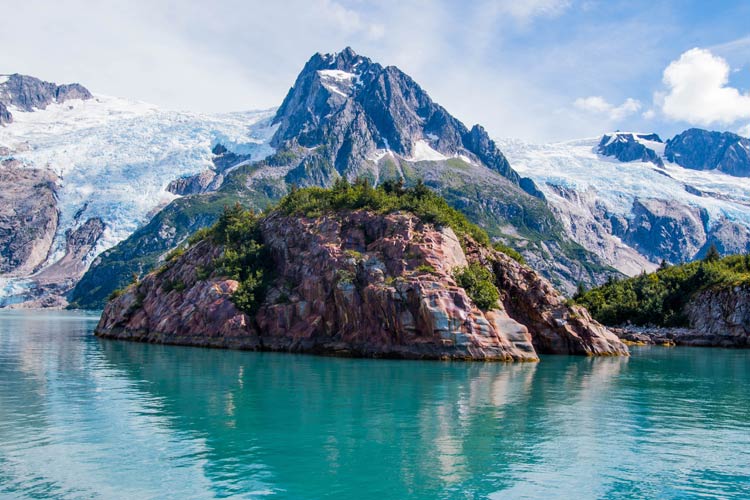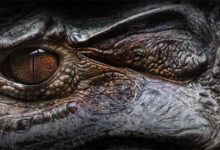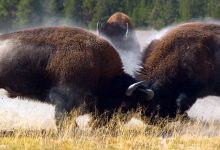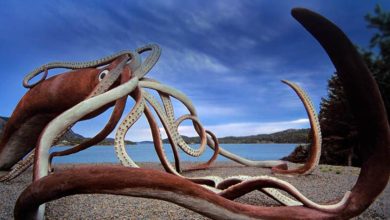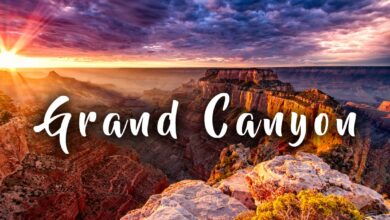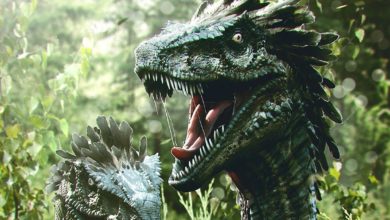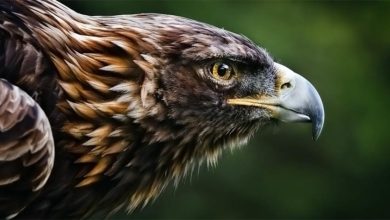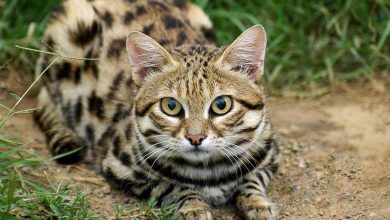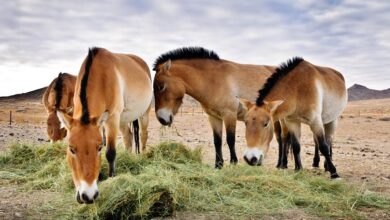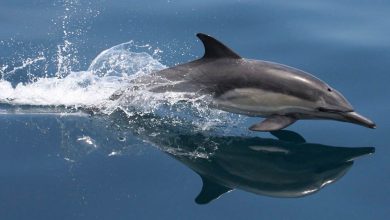Discovering the Glacial Wonders of Kenai Fjords National Park
Kenai Fjords National Park is a national park located in the state of Alaska in the United States. The park encompasses over 669,000 acres (2,711.33 km2) of land and includes the Harding Icefield, glaciers, fjords, and a diverse array of wildlife. The park is known for its spectacular scenery, including towering cliffs, glaciers, and abundant wildlife such as sea otters, seals, and whales. Visitors can explore the park by boat, on foot, or by taking a scenic flight. Popular activities include hiking, fishing, and wildlife viewing. The park is also home to a number of historic sites, including the remains of former mining and fishing settlements.
Nestled on the rugged coast of southern Alaska lies a world of icy wonders, towering peaks, and captivating wildlife: Kenai Fjords National Park. This stunning protected area, spanning over 2,700 square kilometers (1,000 square miles), is a place of unparalleled beauty and natural wonder, where towering glaciers spill into fjords and coves, and a diverse array of marine and terrestrial wildlife call home.
At the heart of the park lies the Harding Icefield, a massive expanse of ice covering over 1,200 square kilometers (460 square miles) and containing more than 30 glaciers. The icefield, which reaches elevations of up to 3,000 meters (10,000 feet), feeds countless rivers, lakes, and waterfalls, and is the source of many of the park’s iconic glaciers, such as Exit Glacier and Bear Glacier.

The park’s coastal waters are a vibrant and bustling ecosystem, home to a wide variety of marine mammals, including sea otters, harbor seals, and Steller sea lions. The waters also attract humpback and orca whales, which migrate through the area each year in search of food. Visitors to the park can explore these waters by taking a boat tour, where they can witness firsthand the majesty of these creatures and the rugged beauty of the park’s coastline.
In addition to its marine life, Kenai Fjords National Park is also home to a diverse array of terrestrial wildlife, including black bears, moose, and mountain goats. The park’s dense forests and alpine meadows provide the perfect habitat for these creatures, and visitors can often spot them while hiking along one of the park’s many trails.
Kenai Fjords National Park is not just a haven for wildlife, however; it is also home to a rich cultural history. The park is situated on the traditional lands of the Dena’ina Athabascan people, who have lived in the area for thousands of years. Visitors to the park can explore the many historical sites and learn about the rich cultural heritage of the region.
With its stunning natural beauty, diverse wildlife, and rich cultural history, Kenai Fjords National Park is a must-visit destination for anyone seeking to experience the rugged and awe-inspiring beauty of Alaska. Whether exploring the park’s many hiking trails, taking a boat tour to witness the majesty of its glaciers and marine life, or simply basking in its serene natural beauty, visitors to this remarkable park are sure to be left with memories that will last a lifetime.
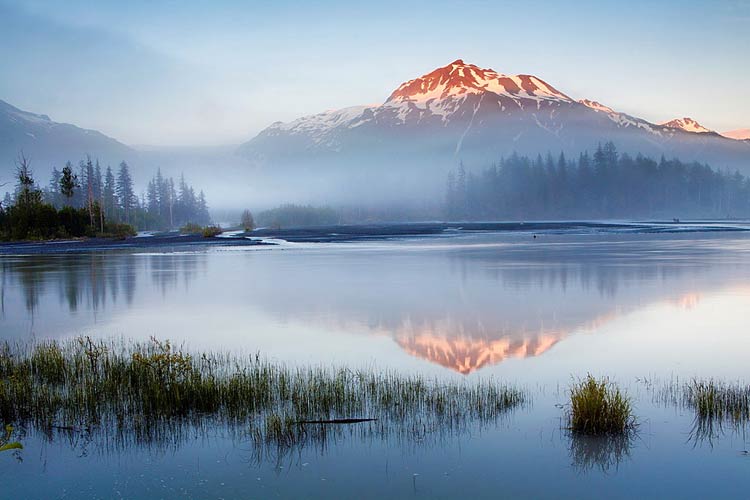
Location
Kenai Fjords National Park is located on the southern coast of Alaska, about 130 miles south of Anchorage. The park covers the Kenai Peninsula and is situated in the municipalities of Seward and Kenai in Alaska. The park is known for its rugged coastline, fjords and glaciers.
The park is easily accessible by road and there are multiple routes to reach the park. The park is surrounded by the Kenai National Wildlife Refuge and the Chugach National Forest, which offer additional opportunities for outdoor recreation and adventure. The nearest airports are the Kenai Municipal Airport and the Ted Stevens Anchorage International Airport.
Basic Facts About Kenai Fjords National Park
Kenai Fjords National Park is located in southern Alaska, covering an area of 669,984 acres (2,711.33 km²). It was established in 1980 to protect the unique fjord and glacier landscapes, wildlife, and marine ecosystems. The park is home to over 38 glaciers, including the Harding Icefield, and a wide range of marine wildlife such as whales, sea otters, and seals.
The park offers a variety of outdoor recreational opportunities, including hiking, kayaking, and boat tours. The climate is characterized by cool, wet summers and mild winters with temperatures ranging from 0°C to 18°C (32°F to 64°F).
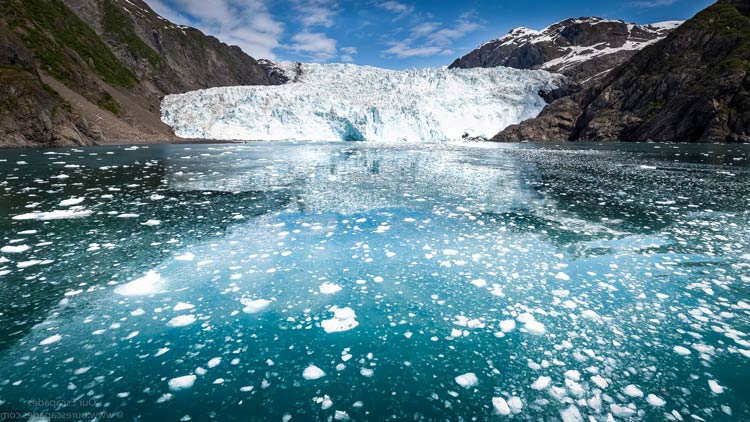
Features of the park
Kenai Fjords National Park is a unique and diverse wilderness area, with a variety of features that make it a popular destination for outdoor enthusiasts and nature lovers. Here are some of the notable features of the park:
- Fjords
The park is home to numerous fjords, which are long, narrow inlets of the sea surrounded by steep cliffs or slopes. The fjords were carved by glaciers over thousands of years and are a major attraction in the park. - Glaciers
Kenai Fjords National Park is home to over 38 glaciers, including the Harding Icefield, which is one of the largest icefields in the United States. These glaciers are constantly changing and are a testament to the power of nature. - Wildlife
The park is home to a wide range of wildlife, both on land and in the sea. Visitors can spot marine mammals such as whales, sea otters, and seals, as well as land animals such as bears, moose, and wolves. - Mountains
The park is home to several mountain ranges, including the Harding and Kenai Mountains. These mountains provide a stunning backdrop to the park’s fjords and glaciers. - Forests
The park is also home to several different types of forests, including Sitka spruce, western hemlock, and mountain hemlock. These forests provide habitat for a variety of wildlife and are a beautiful sight to see. - Lakes and rivers
The park contains several lakes and rivers, including the Harding Icefield and Exit Glacier Rivers. These bodies of water provide opportunities for kayaking, fishing, and other recreational activities.
Kenai Fjords National Park is a stunning wilderness area that offers visitors a unique and unforgettable experience.
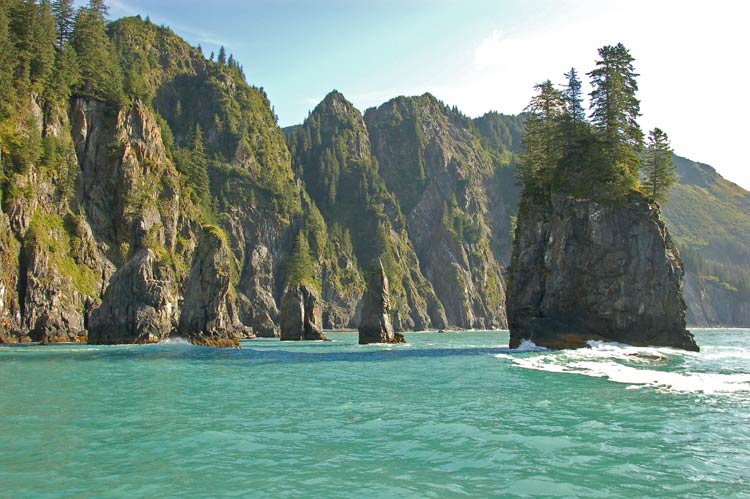
History and Name of the Park
Kenai Fjords National Park was established in 1980 as a result of the Alaska National Interest Lands Conservation Act (ANILCA). The park was created to protect and preserve the natural beauty and resources of the area, including the Harding Icefield, glaciers, fjords, and wildlife. The park is named for the many fjords that can be found along the park’s coast.
A fjord is a long, narrow inlet of the sea between high cliffs or mountainous terrain, typically formed by glacial erosion. The park is home to several large glaciers, including Exit Glacier which is one of the most easily accessible glaciers in Alaska. The park was created to protect and preserve the natural beauty and resources of the area, including the Harding Icefield, glaciers, fjords, and wildlife.
Etymology of the name of the park
The name “Kenai Fjords National Park” is derived from the Kenai Peninsula, where the park is located, and the numerous fjords that can be found in the area. The Kenai Peninsula was named after the Kenaitze people, a native Alaskan tribe that has inhabited the region for thousands of years.
The word “kenai” means “flat land with few trees” in the Dena’ina Athabascan language, which is spoken by the native Athabascan people of the area. The word “fjord” comes from the Norwegian word “fjord”, which refers to a long, narrow inlet of the sea that is surrounded by steep cliffs or slopes. The park’s name reflects the unique combination of the area’s native heritage, geological features, and maritime landscapes.
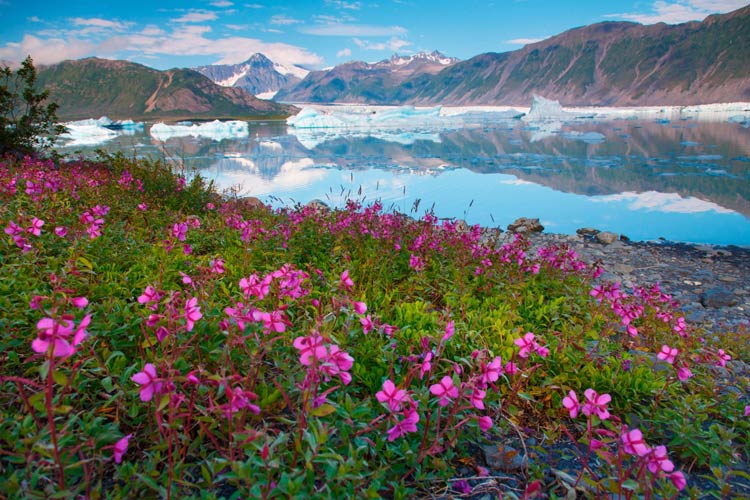
Geography
Kenai Fjords National Park covers an area of over 660,000 acres and is located in the southern coast of Alaska. The park is situated on the Kenai Peninsula and encompasses a diverse range of landscapes and features, including rugged coastline, fjords, glaciers, and the Harding Icefield. The park is known for its spectacular scenery, including towering cliffs, glaciers, and abundant wildlife such as sea otters, seals, and whales.
The park’s topography is characterized by steep, mountainous terrain and deep fjords that were carved by glaciers during the last Ice Age. The park’s highest point is Truuli Peak, which stands at an elevation of 7,400 feet. The park’s main feature is the Harding Icefield, which is one of the largest ice fields in the United States. The ice field covers an area of over 300 square miles and is the source of several glaciers, including Exit Glacier which is one of the most easily accessible glaciers in Alaska.
The park’s diverse ecosystem supports a wide range of plant and animal life, including several species of fish, birds, and mammals such as brown bears, wolves, and moose. The park’s coastal waters are home to many marine mammals, including sea otters, seals, and whales. The park’s rugged coastline and fjords provide important habitats for seabirds and other marine species.
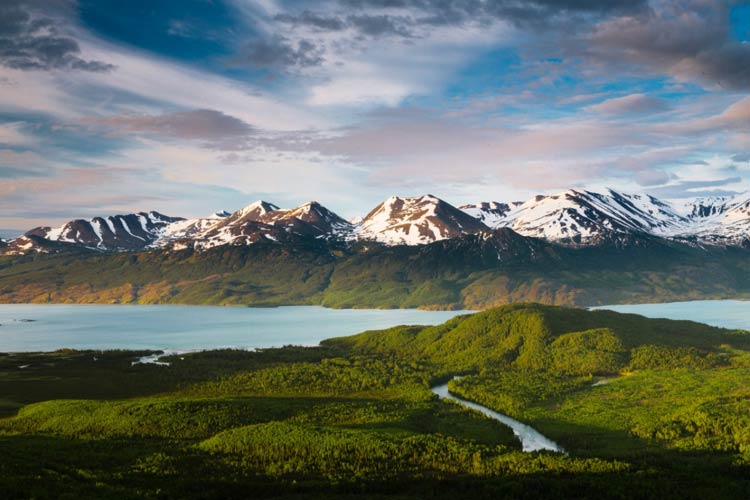
Geology
Kenai Fjords National Park is known for its geologic diversity and features that have been shaped by various processes over time. The park’s geologic history can be traced back millions of years, to the time when the region was part of a massive mountain range that was uplifted and then worn down by erosion.
The park’s current geologic features were primarily shaped by glacial activity during the last Ice Age. The park’s fjords were carved by glaciers as they moved through the area, leaving behind a unique landscape of steep-sided valleys and U-shaped cross-sections. The park is also home to several glaciers, including Exit Glacier, which is one of the most easily accessible glaciers in Alaska. The Harding Icefield, the largest ice field in the United States outside of Alaska, is another important feature of the park, it covers an area of over 300 square miles and is the source of several glaciers.
The park’s geologic history has also been influenced by volcanic activity, The park’s terrain is made up of sedimentary, metamorphic and igneous rock. The park’s coastal cliffs are composed mainly of sandstone and shale, while the park’s mountains are made up of granite and other igneous rocks.
Overall, the park’s geology is a product of a complex interplay of tectonic, glacial and volcanic processes that have shaped the landscape over millions of years. The park’s geologic features are an important aspect of its natural beauty and scientific value, and they continue to shape the park’s ecosystem and natural resources today.
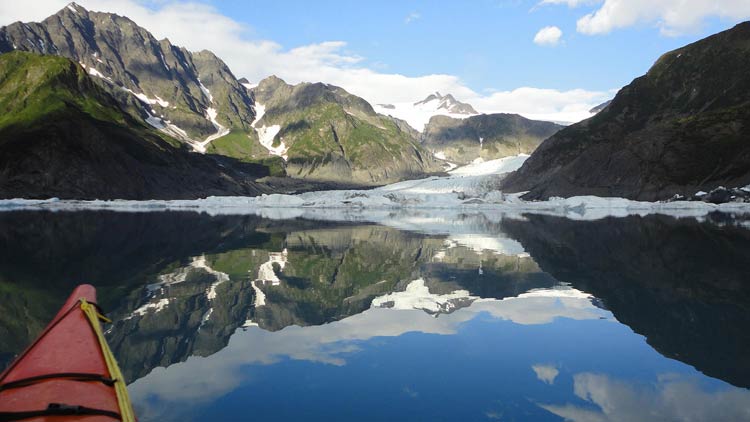
Exit Glacier
Exit Glacier is a glacier located in Kenai Fjords National Park in Alaska. It is one of the most accessible glaciers in the park and is a popular destination for visitors. The glacier is situated on the western side of the Kenai Mountains and is part of the Harding Icefield, which covers an area of over 300 square miles.
The glacier is a popular spot for hiking, and visitors can take a ranger-led hike to the glacier’s edge or hike on their own on a designated trail. The Exit Glacier Nature Center is also located at the glacier’s edge, and it provides information about the glacier’s history and geology as well as about the surrounding ecosystem.
Exit Glacier is also an important spot for research and education, as it is one of the most rapidly receding glaciers in Alaska. Scientists have been monitoring the glacier’s retreat for decades and have documented a significant loss of ice mass. This retreat is due to a combination of factors, including rising temperatures and changes in precipitation patterns.
Exit Glacier is also home to a variety of wildlife, including black bears, mountain goats, and a wide variety of birds and fish. Visitors should be aware that bears are common in the area and should take appropriate safety precautions when hiking in bear country.
Exit Glacier is also a place where you can see the effects of global warming up close. The glacier has receded over 1.25 miles since 1815, and continues to recede at a rate of about 30-40 feet per year.
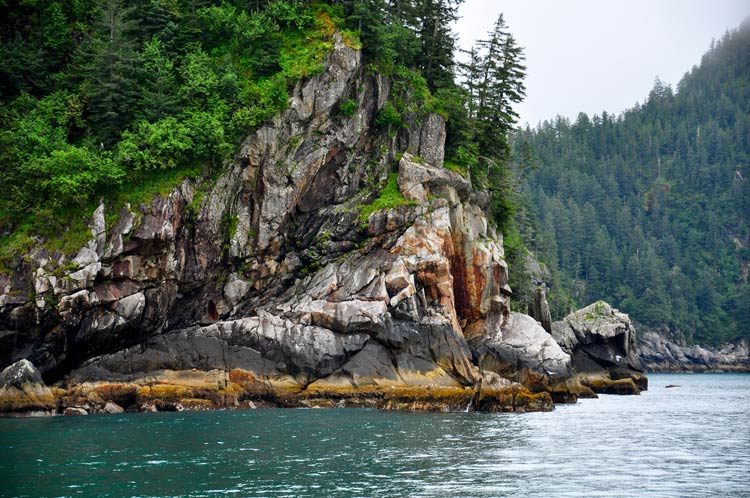
Climate
Kenai Fjords National Park has a subarctic coastal climate, characterized by cool temperatures, high precipitation, and a long period of daylight during the summer months. The park’s climate is influenced by the Gulf of Alaska and the Pacific Ocean, which moderate temperatures and bring a high amount of precipitation to the area.
The park’s temperatures vary depending on the season, with average summer temperatures ranging from 40 to 60°F (5 to 15°C) and winter temperatures ranging from 20 to 40°F (-6 to 4°C). The park is known for its cool and wet weather, with an annual precipitation of around 70 inches (178 cm) of rain and snow. The park’s coastal areas can experience strong winds, especially during the winter months.
The park’s long summer days, with up to 24 hours of daylight, are a result of its location above the Arctic Circle. This extended daylight period allows for a long hiking and sightseeing season, and it is particularly beneficial for visitors interested in wildlife viewing and photography.
Overall, the park’s climate can be challenging for visitors, with cool temperatures, high precipitation, and strong winds. Visitors should be prepared for inclement weather and pack warm clothing and rain gear. The park’s weather can change rapidly, so visitors should be prepared for a range of conditions.
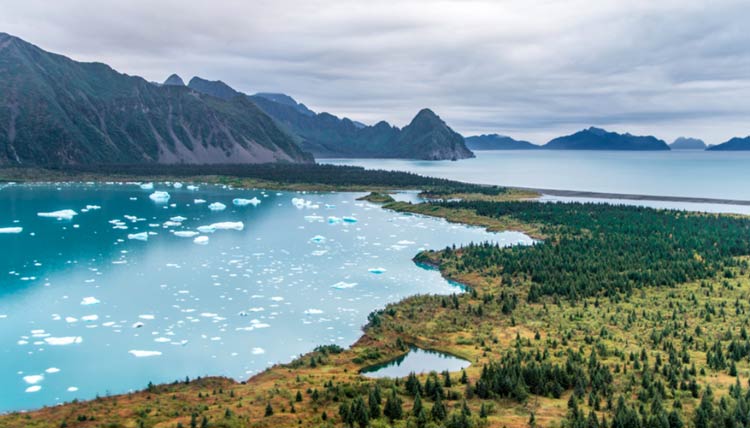
Flora in Kenai Fjords National Park
Kenai Fjords National Park is home to a diverse range of plant life, with a variety of habitats that support a wide range of species. The park’s vegetation varies depending on the elevation, exposure, and soil conditions.
The park’s low-lying coastal areas are characterized by a dense cover of vegetation, including grasses, sedges, and mosses. These areas also support a variety of wildflowers, including fireweed, lupine, and wild roses. Higher elevations are characterized by the alpine tundra, which is a treeless ecosystem that is dominated by low-growing shrubs and small flowers. The alpine tundra is home to a variety of plants such as dwarf willow, mountain avens, and moss campion.
The park’s forests are primarily composed of Sitka spruce and western hemlock, which are well adapted to the area’s cool, wet climate. These forests provide important habitat for a variety of wildlife, including birds, bears, and deer. The park’s wetlands and riparian zones are also important habitats for a variety of plant and animal life.
The park’s glaciers and icefields are covered by ice and snow, and do not support any vegetation. However, the areas around the glaciers and icefields are known for their unique plant life that has adapted to the harsh conditions. The park’s Exit Glacier area has a small area of subalpine forest and wetland, where you can find a variety of wildflowers, shrubs, and grasses.
Overall, the park’s flora is an important aspect of its natural beauty and ecological value, and it supports a wide range of plant and animal life. Visitors should be mindful of the park’s sensitive plant life and take care to avoid trampling or disturbing the vegetation.
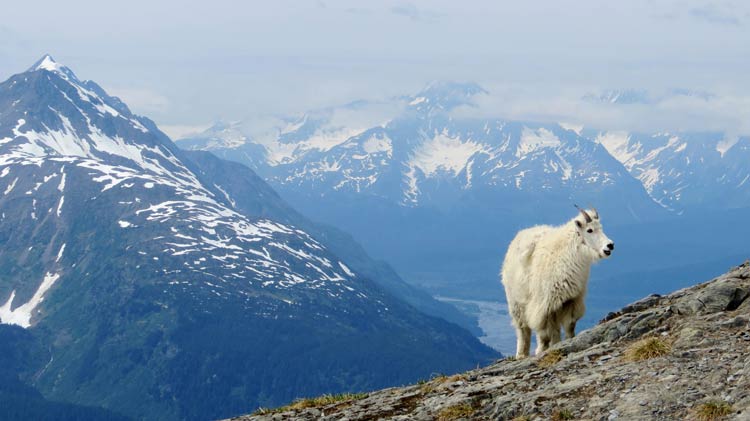
Fauna in Kenai Fjords National Park
Kenai Fjords National Park is home to a diverse range of wildlife, with a variety of habitats that support a wide range of species. The park’s fjords, glaciers, forests, and coastal areas provide important habitat for a variety of mammals, birds, fish, and invertebrates.
- The park’s marine environment supports a variety of marine mammals, including sea otters, harbor seals, and sea lions. The park’s coastal waters are also home to a variety of whales, including humpback whales, orcas, and gray whales. These marine mammals can be observed from boats or during guided tours.
- The park’s terrestrial environment is home to a variety of mammals, including black bears, moose, and mountain goats. The park’s forests are also home to a variety of birds, including eagles, owls, and woodpeckers. The park’s alpine tundra and glaciers are home to a variety of birds, such as ptarmigans, snow buntings, and falcons.
- The park’s freshwater rivers and streams are home to a variety of fish, including salmon, steelhead, and Dolly Varden. The park’s wetlands and riparian zones are also important habitats for a variety of plant and animal life.
The park’s fauna is an important aspect of its natural beauty and ecological value. Visitors should be mindful of the park’s wildlife and take care to avoid disturbing or harassing the animals. Visitors should also be aware of the park’s bear safety guidelines and follow them closely.
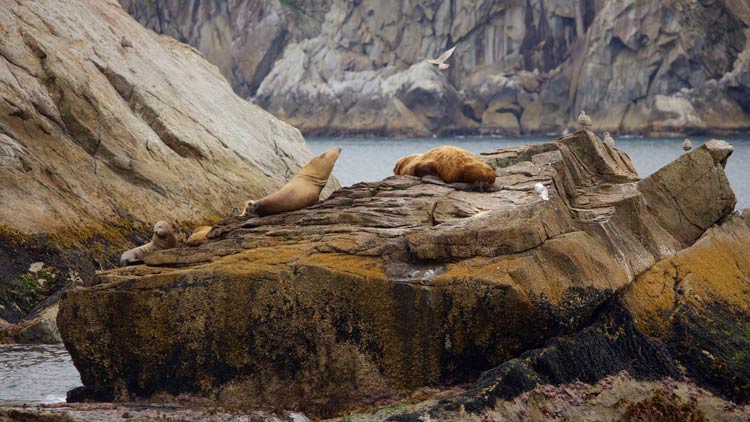
Tourism and tourist main attractions in the park
Kenai Fjords National Park is a popular tourist destination, known for its spectacular fjords, glaciers, and wildlife. The park attracts visitors from all over the world, who come to experience its natural beauty and outdoor recreational opportunities.
- The park’s main attraction is its fjords, which are deep inlets of the sea that are carved by glaciers. Visitors can take boat tours to explore the park’s fjords and view the glaciers and wildlife from the water. Boat tours are a popular way to explore the park, and they provide an excellent opportunity to see marine mammals, such as whales and sea otters, as well as birds and fish.
- The park’s glaciers are also a major attraction. Visitors can take guided hikes on the Exit Glacier, which is one of the park’s most accessible glaciers. The Exit Glacier area is also home to a visitors center and an interpretive trail. Visitors can also take a helicopter or skiplane tour to view the park’s more remote glaciers and icefields.
- The park’s wildlife is another major attraction. Visitors can see a variety of marine mammals, such as whales, sea otters and seals, and terrestrial mammals such as black bears, moose, and mountain goats. The park’s forests, alpine tundra, and wetlands are also home to a variety of birds and fish.
- Other popular activities in the park include hiking, camping, fishing, and kayaking. The park also offers a variety of ranger-led programs, such as guided hikes and wildlife viewing tours, that provide visitors with an opportunity to learn more about the park’s natural and cultural history.
Kenai Fjords National Park offers a wide range of activities and attractions for visitors, including boat tours, glacier viewing, wildlife watching, and outdoor recreational opportunities. Visitors should plan their trip in advance and be prepared for the park’s challenging weather and rugged terrain.
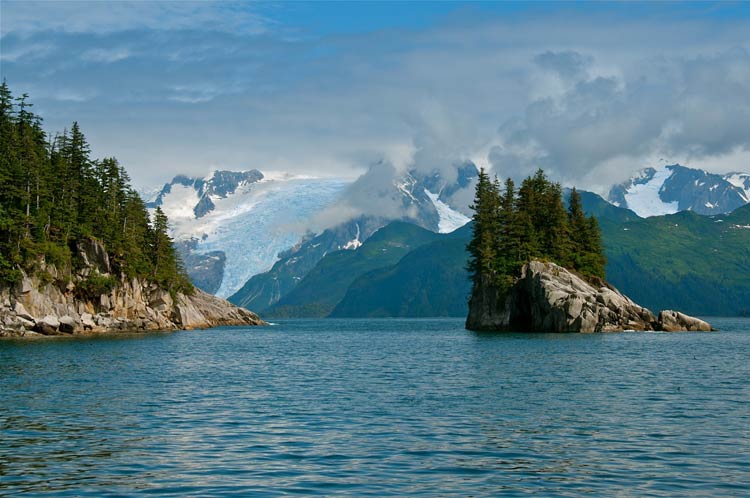
Places to visit in the park
Kenai Fjords National Park has many breathtaking sights to see and activities to experience. Here are some of the top places to visit in the park:
- Exit Glacier
This is one of the most popular attractions in the park, and for good reason. It’s a relatively easy hike to get to the glacier, and once you’re there, you can get up close and personal with the icy blue mass. - Harding Icefield
This is a massive icefield that covers more than 300 square miles and feeds many of the glaciers in the park. There are several trails that lead to viewpoints overlooking the icefield, and guided tours are also available. - Aialik Glacier
This is one of the most impressive glaciers in the park, and you can get close to it on a boat tour. The glacier is constantly calving, which means you’ll likely see chunks of ice falling into the water. - Resurrection Bay
This is a stunning bay that’s home to an abundance of marine life, including sea otters, whales, and seabirds. Boat tours of the bay are a popular way to explore the area. - Fox Island
This is a small island located within Resurrection Bay, and it’s a great place to go kayaking, hiking, or camping. You can also take a boat tour to the island for a picnic or a beachcombing adventure.
These are just a few of the many amazing places to visit in Kenai Fjords National Park. With so much to see and do, it’s no wonder this park is a must-visit destination for nature lovers.
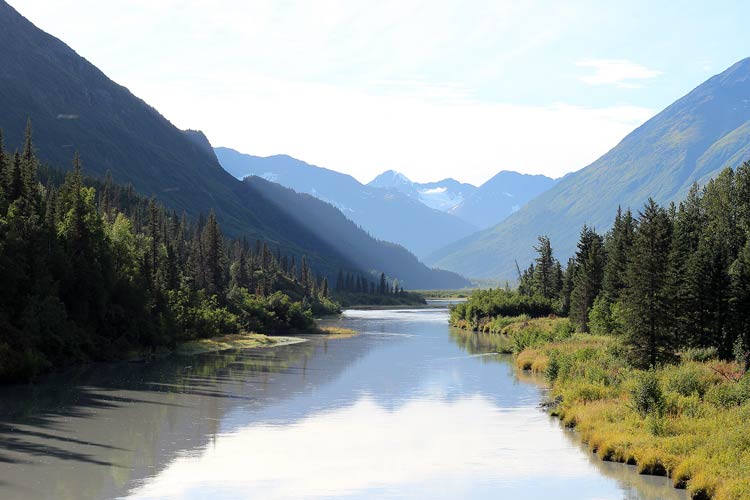
How To Reach To Kenai Fjords National Park?
Kenai Fjords National Park is located in south-central Alaska, and while it is a remote location, it is still accessible by a few different methods.
- By air
The closest major airport to Kenai Fjords National Park is Ted Stevens Anchorage International Airport, located in Anchorage, Alaska. From there, visitors can take a small plane or helicopter to the park. - By car
Visitors can also drive to Seward, which is the closest town to the park, and then take a boat tour or hike into the park. Seward is located approximately 125 miles south of Anchorage and can be reached via the Seward Highway. - By train
The Alaska Railroad offers service to Seward from Anchorage, Fairbanks, and other locations. This is a scenic way to travel to the park and offers views of the stunning Alaska wilderness along the way.
Once in the park, visitors can access various areas by hiking, boating, or kayaking. However, it is important to note that the park is largely wilderness and some areas may be inaccessible or difficult to reach. Visitors should be prepared with the proper gear, including bear spray, and should be knowledgeable about wilderness safety.

Best Time To Visit Kenai Fjords National Park
The best time to visit Kenai Fjords National Park depends on what you want to do and see. The park is open year-round, but certain activities and attractions are only available during specific seasons. Here are some factors to consider:
- Wildlife
The best time to see wildlife is during the summer months, from May to September. This is when many animals, including whales, sea otters, and seabirds, are most active and visible. - Glaciers
If you want to see glaciers up close, the best time to visit is in the summer months, when boat tours to the park’s glaciers are available. - Weather
The weather in Kenai Fjords National Park can be unpredictable, but the summer months are generally the warmest and driest. However, keep in mind that temperatures can still be cool, and rain is always a possibility. - Crowds
The summer months are the busiest time in the park, so if you want to avoid crowds, consider visiting in the shoulder seasons of May or September.
The best time to visit Kenai Fjords National Park is during the summer months, from May to September, when the weather is the warmest and many of the park’s attractions are accessible. However, each season has its own unique advantages and challenges, so it’s important to consider your interests and preferences when planning your visit.
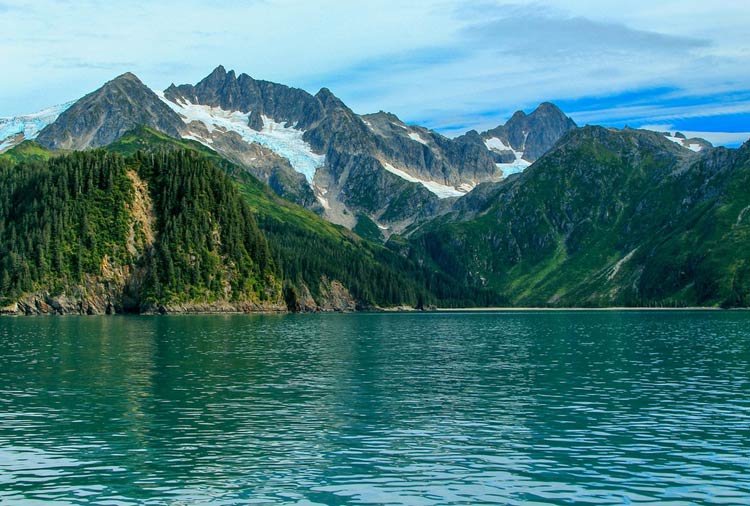
Conservation in Kenai Fjords National Park
Kenai Fjords National Park is committed to conservation and protecting the natural environment. Here are some of the conservation efforts being undertaken in the park:
- Wildlife Protection
The park is home to many species of wildlife, including humpback whales, sea otters, and bald eagles. Park rangers monitor these populations to ensure their health and safety. - Sustainable Tourism
The park works to balance the needs of visitors with the preservation of natural resources. Efforts include promoting low-impact activities and educating visitors on responsible outdoor practices. - Climate Change Research
The park is actively engaged in climate change research to better understand the impacts of warming temperatures and melting glaciers on the park’s ecosystems. - Habitat Restoration
The park is working to restore damaged areas to their natural state. This includes restoring areas that have been affected by wildfires and removing invasive plant species. - Marine Conservation
The park is home to important marine ecosystems, and efforts are underway to protect these areas from overfishing, pollution, and other threats.
These are just a few examples of the conservation efforts being undertaken in Kenai Fjords National Park. Through these initiatives and more, the park is working to ensure that future generations can continue to enjoy the natural beauty and resources of this special place.

Kenai Fjords National Park in numbers
- Size
The park covers an area of 669,984 acres (2,711.33 km2), making it larger than the state of Rhode Island. - Glaciers
The park contains at least 38 glaciers, covering over 700 square miles (1,800 km2) of the park. - Wildlife
The park is home to over 191 bird species, 38 mammal species, and 10 fish species. - Visitors
In 2021, the park welcomed over 382,000 visitors, making it one of the most visited national parks in Alaska. - Harding Icefield
The Harding Icefield covers an area of 300 square miles (780 km2) and is the largest icefield contained entirely within the United States. - Fjords
The park contains many fjords, including Aialik Bay, Harris Bay, and Holgate Arm. - Coastal Trail
The park’s Coastal Trail is 8.2 miles (13.2 km) long and offers stunning views of the fjords and glaciers. - Elevation
The park’s highest point is Mount Alice at 5,000 feet (1,524 meters) above sea level. - History
The park was established in 1980, but the area has been inhabited by Indigenous peoples for thousands of years. - Research
The park hosts multiple research projects, including climate change studies, wildlife surveys, and glacial monitoring.
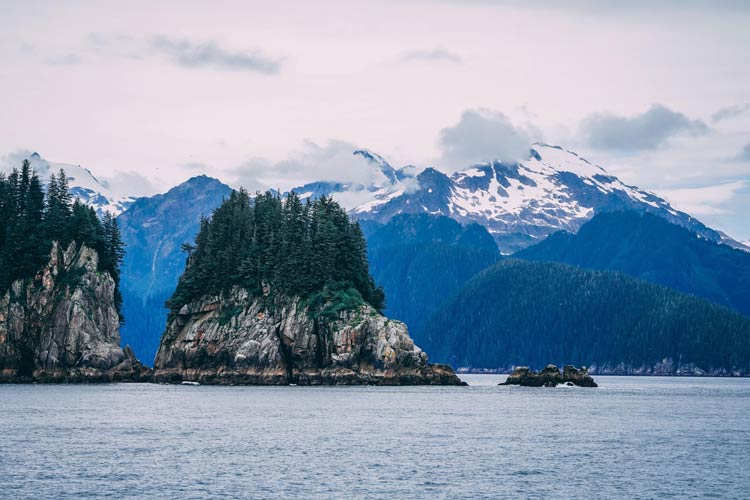
Interesting Facts about Kenai Fjords National Park
- Kenai Fjords National Park is located on the Kenai Peninsula in southern Alaska, and it encompasses an area of over 669,984 acres.
- The park was established in 1980 by the Alaska National Interest Lands Conservation Act.
- The park’s name comes from the fjords, which are deep inlets of the sea that are carved by glaciers. The park contains over 40 glaciers, including the massive Harding Icefield, which covers an area of over 300 square miles.
- Kenai Fjords is home to an array of wildlife, including sea otters, harbor seals, sea lions, humpback whales, orcas, gray whales, black bears, moose, mountain goats, and a wide variety of birds and fish.
- The park is also home to a number of historic sites, including the abandoned town of Seward, which was a major port during the gold rush of the late 1800s.
- The park’s Exit Glacier is one of the most accessible glaciers in Alaska, and it is an important spot for research and education. Visitors can walk right up to the glacier, and even hike on it with a guide.
- Kenai Fjords is also home to the Aialik Glacier, which is one of the most actively calving glaciers in Alaska.
- The park is a popular destination for hiking, kayaking, camping, and fishing, as well as for wildlife viewing and glacier viewing.
- The park’s weather can be challenging, and visitors should be prepared for cold temperatures, high winds, and heavy rain.
- The park’s visitor center is located in the town of Seward, and it provides information about the park’s natural and cultural history, as well as maps, brochures, and other educational materials.
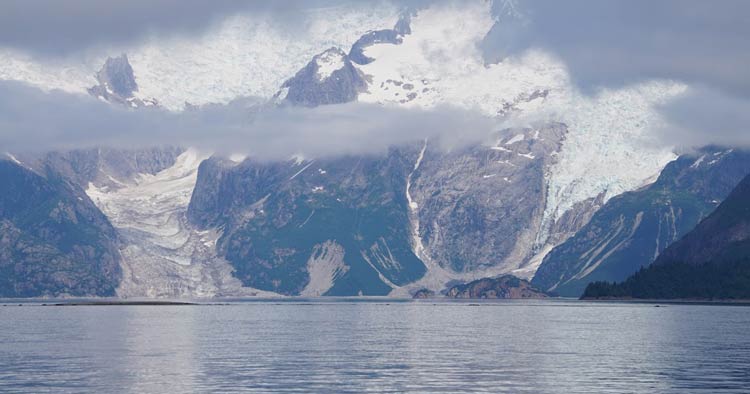
Q&A (questions and answers) about Kenai Fjords National Park
Q: What is Kenai Fjords National Park?
A: Kenai Fjords National Park is a national park located on the Kenai Peninsula in southern Alaska, known for its spectacular fjords, glaciers, and wildlife.
Q: When was Kenai Fjords National Park established?
A: Kenai Fjords National Park was established in 1980 by the Alaska National Interest Lands Conservation Act.
Q: What is the origin of the name of the park?
A: The park’s name comes from the fjords, which are deep inlets of the sea that are carved by glaciers.
Q: What kind of wildlife can be found in Kenai Fjords National Park?
A: Kenai Fjords National Park is home to an array of wildlife, including sea otters, harbor seals, sea lions, humpback whales, orcas, gray whales, black bears, moose, mountain goats, and a wide variety of birds and fish.
Q: What are some popular activities in Kenai Fjords National Park?
A: Popular activities in Kenai Fjords National Park include hiking, camping, fishing, kayaking, boat tours, glacier viewing, and wildlife watching.
Q: What should visitors be prepared for when visiting Kenai Fjords National Park?
A: Visitors should be prepared for cold temperatures, high winds, and heavy rain. They should also be aware that the park’s weather can be challenging and that the park’s terrain is rugged.
Q: Where is the park’s visitor center located?
A: The park’s visitor center is located in the town of Seward, and it provides information about the park’s natural and cultural history, as well as maps, brochures, and other educational materials.
